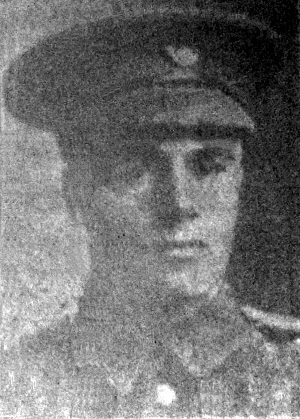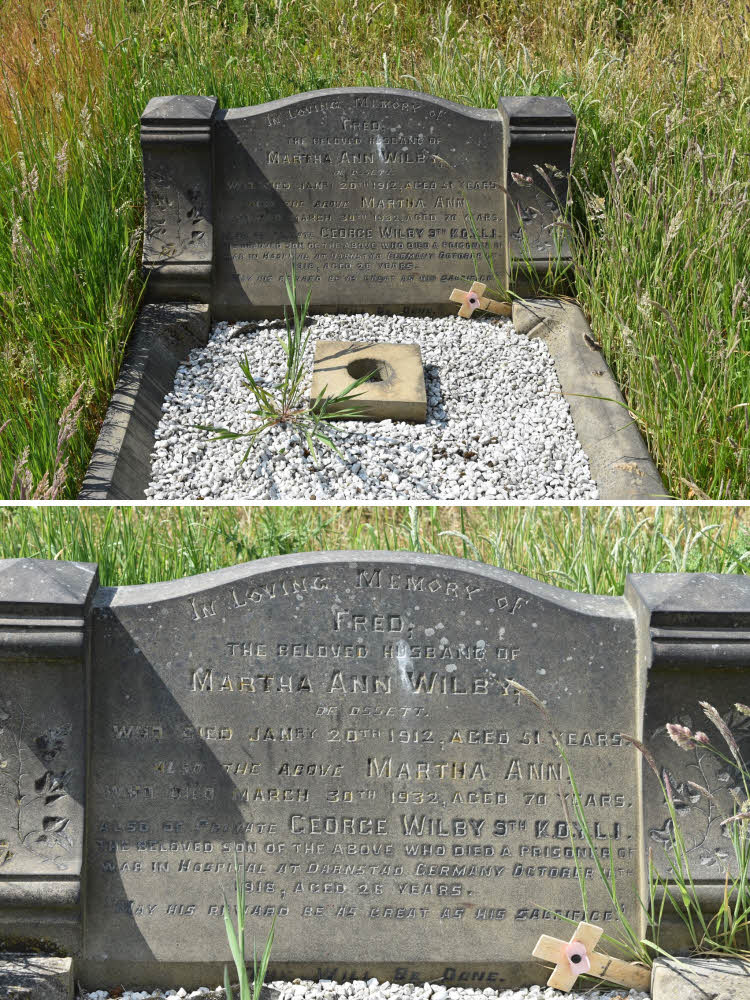
27881, King’s Own Yorkshire Light Infantry, 9th Battalion
George Wilby was born in Ossett in late 1891, the son of tobacconist and shopkeeper Fred Wilby and his wife Martha Ann (nee Gower) who had married on the 19th of February 1882 at Dewsbury All Saints Church.
The couple had four children, two boys and two girls. George was the youngest child. In 1901 they are living on The Green, Ossett, next to the Station House.
By 1911, George is aged 19, and was working a postman, living on The Green with his parents and his youngest sister. George’s father, Fred died in 1912, aged 51. It seems likely that his widow moved to nearby George Street sometime after his death. Between 1913 and 1915, there are three different Wilby families living on George Street and the widowed Martha Wilby may have moved to be close to them.
The 9th (Service) Battalion of KOYLI was formed at Pontefract in September 1914 as part of K3 and came under command of 64th Brigade in 21st Division. The battalion moved to Berkhamsted and then to Halton Park (Tring) in October 1914, going on to billets in Maidenhead in November. They returned to Halton Park in April 1915 and went on to Witley in August. In September 1915 they landed in France.
George Wilby’s KOYLI 9th Battalion was one of the lead battalions of the 64th Brigade (21st Division) on the opening day of the Battle of the Somme, 1st July 1916, just north of Fricourt and south of Sausage valley. In all the action on the Somme between 1st July and the 18th November 1916, 9th Battalion, KOYLI lost 358 men killed. It seems that George Wilby survived, although he was wounded in September 1916. Private Wilby was also wounded on Easter Monday, 9th April 1917 during the First Battle of the Scarpe.
On the 26th August 1918, the 9th Battalion, KOYLI were formed up with others from 64 Brigade in a 4km line west to east north of Le Sars. The 64th Brigade had formed up for an attack on German positions very early on 26th, the objective of the attack being the Ligny Thilloy – Flers road. The 15th DLI and the 9th KOYLI were the attacking Battalions, with the 1st East Yorkshires, in support. It is likely that George Wilby was wounded and subsequently captured by the Germans during this action.
The “Ossett Observer” 1 had this obituary for George Wilby:
“Reported Death Of An Ossett Soldier In Germany – Anxiety is felt as to the fate of Private George Wilby, King’s Own Yorkshire Light Infantry, the youngest son of Mrs. F. Wilby, widow, of George-street, Healey-road, Ossett, who after going through a lot of fighting, and figuring several times among the the casualties, was captured by the enemy this year. During his captivity, news has from him that he was in hospital, and the last occasion on which he wrote, early in October, he said that he was much better in health. On Wednesday morning Mrs. Wilby received a letter from someone who had a soldier son in the same prisoners’ hospital in Germany, stating that this son had written home, saying that Private Wilby had died. The communication was dated the day after Private Wilby had wrote. No official intimation has been received from the authorities, and the mother and relatives of Private Wilby are naturally in a state of great suspense.”
Earlier in a May 1917 “Ossett Observer”:
“Private George Wilby, (K.O.Y.L.I.), youngest son of Mrs. F. Wilby, George-street, Healey-road, Ossett sustained a bullet wound in the leg on Easter Monday, and is in hospital in France. He had been previously wounded in September last.”
Private George Wilby, died on the 10th October 1918, aged 26 years, the youngest son of Mrs F. Wilby, of George Street, Healey Road, Ossett, Yorkshire. His army record has not survived, but he was awarded the British and Victory medals posthumously. He was not awarded the 1914-15 Star, so he wasn’t serving overseas on the 31st December 1915.
George Wilby is buried at grave reference I. G. 4. in Niederzwehren Cemetery, 2 Hessen, Kassel, Germany. The city of Kassel lies in the centre of Germany approx 165kms south of Hannover.
The cemetery was begun by the Germans in 1915 for the burial of prisoners of war who died at the local camp. During the war almost 3,000 Allied soldiers and civilians, including French, Russian and Commonwealth, were buried there.
In 1922-23 it was decided that the graves of Commonwealth servicemen who had died all over Germany should be brought together into four permanent cemeteries. Niederzwehren was one of those chosen and in the following four years, more than 1,500 graves were brought into the cemetery from 190 burial grounds in Baden, Bavaria, Hanover, Hesse and Saxony.
There are now 1,796 First World War servicemen buried or commemorated in the Commonwealth plot at Niederzwehren. This total includes special memorials to 13 casualties buried in other cemeteries in Germany whose graves could not be found.

Above: The Wilby grave at St. John’s Methodist Chapel showing the memorial to George Wilby, the son of Fred Wilby. Picture courtesy of Lisa Jennings.
References:
1. “Ossett Observer”, 7th December 1918